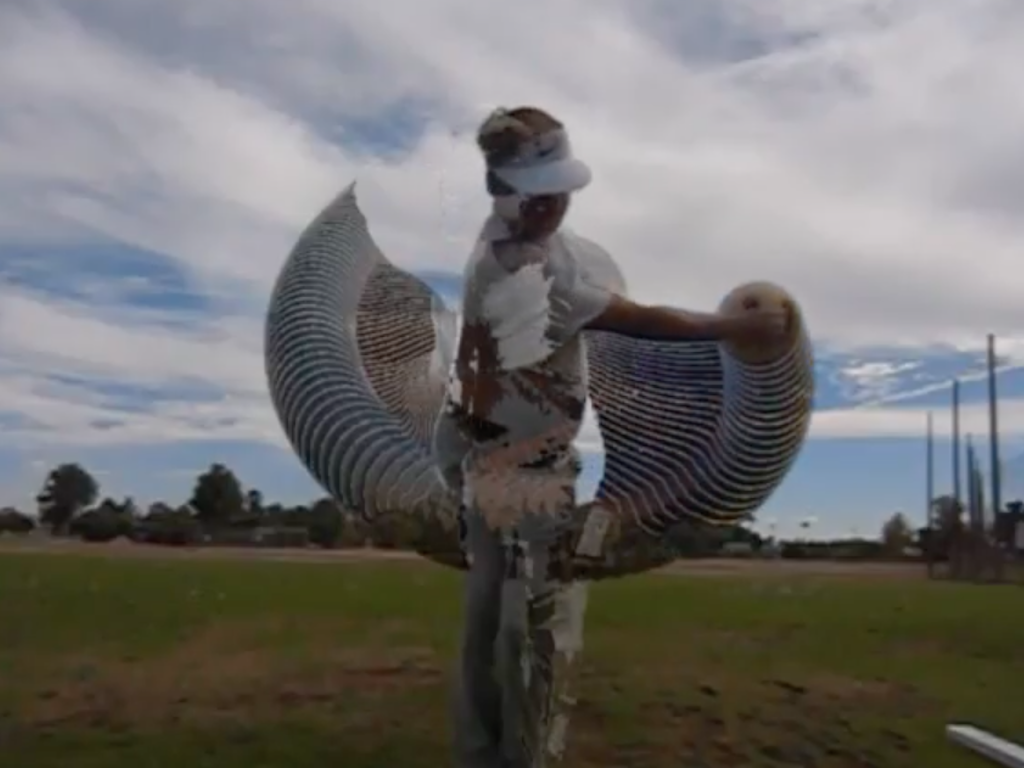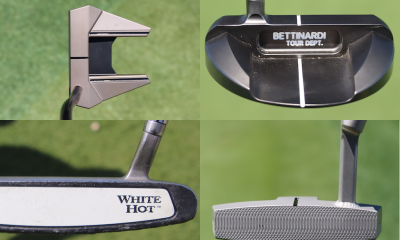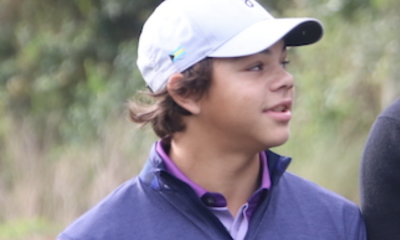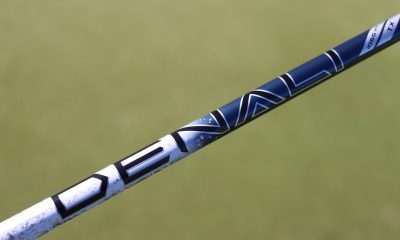Instruction
Expand the Radius for Pure Ball-Striking

There is a specific element of the swing that all good ball-strikers possess. It can be summed-up many different ways, lending to the often confusing terminology of golf instruction, but perhaps the best description is the following: good ball strikers, except for with the driver and putter, create a bottom or low-point of the clubhead swing/arc that is a few inches ahead of the ball.
In his book “The Impact Zone,” former PGA Tour player Bobby Clampett clearly made his feelings known on the matter by stating that for all types of player concerns, his best response was to “get the bottom of the swing 4 inches ahead of the ball.” Four inches may be the high end of the effective range, but still, I’m in agreement with Bobby on the paramount importance of this element of the swing.
Why is this so important?
Achieving a “forward” low point allows the golfer to deliver the clubhead to the ball with a slightly descending attack angle. Due to the design of the small golf ball and lofted face of golf clubs, “hitting down on the ball” slightly is a must for clean contact on the “sweet spot” of the clubface. Also, the bio-mechanics involved in creating a forward low-point will naturally return the club face squarely back to its starting alignment relative to the path/plane of the swing. The “dub,” as Bobby Jones rather bluntly referred to him (or her) who struggles to achieve both of these clubhead delivery conditions satisfactorily, is thus both a “flipper” and a “slicer.”
OK, so how do we do it?
Intentions, feels, and swing thoughts – different terms for the same thing — that can help the golfer achieve a forward low-point are limitless. But the following is one of the very best that I know of: expand the radius of the hand-path through impact. In terms of space, we’re talking “past the ball.” But I prefer this intention in relation to time or impact, which is more feel-based.
The hands swing around a point located near the golfer’s upper core area. At the start of the swing, both arms are essentially straight. The radius of the swing of the hands is widest and the distance from the hands to the center is greatest when both arms are straight. In the backswing, the left arm remains straight while the right arm bends up to a 90-degree angle, at which time the radius is at its most narrow, the hands closest to the center. At the strike point, good ball-strikers are expanding the radius of the swing of the hands, in turn widening the arc of the clubhead past impact. Without this bio-mechanical feature to the swing, achieving a swing bottom several inches ahead of the ball is virtually impossible, as the clubhead will release prematurely to its bottom.
How do you know if you’re doing it?
Besides creating proper clubhead delivery and an unmistakably “pure” strike, the trail arm should be observed with high-speed video to be straightening at impact. In a proper full swing, full-radius and the classic both-arms-straight position is reached just after impact.
A natural practice drill to acquire this skill
Ben Hogan, in his landmark instruction book, “Ben Hogan’s Five Lessons: The Modern Fundamentals of Golf,” described the forward swing motion into impact like throwing a small-sized medicine ball. For a number of years now, I have been using a six-pound medicine ball with handles, for myself as well as my students, as an essential training aid to loosen-up and acquire the correct bio-mechanical movements of the swing. Whether you actually let go of the ball or not, the correct motion is the same:
- Start with both arms straight.
- Swing the medicine ball, which represents the hands in the golf swing, around a fixed point in the upper core, near the sternum.
- At the end of the backswing, the lead arm should still be straight while the trail arm has bent to an approximately 90-degree angle.
- The primary intention is for the forward swing and is to push the medicine ball outward from your center, reaching full-radius/both-arms-straight again ideally at a point in-line with your lead shoulder/foot. This movement will allow you to achieve a clubhead low point ahead of any golf ball positioned behind your lead shoulder.
A word of warning
It is possible to extend the radius of the hands too far past the ball. This is largely a problem limited to better players. The buzz term I hear for this nowadays is “handle-dragging.” An effective fix, as you might now imagine, is to intend to expand to full-radius sooner. But in over 20 years of teaching predominately the golfing population at large, I would say that for every one player that I see who expands the radius too far past the ball, I see many more times that who do not expand the radius sufficiently past impact.
It works like this; if you usually strike the ball first, but then take deep, gouging divots, and struggle to achieve a satisfactory height to your approach shots, then more than likely you actually are the rare “handle-dragger.” But if you are like the majority of recreational players who do not typically strike the ball first and then take a proper, shallow divot with your irons and feel that you hit them too high but without sufficient distance, then you are the opposite of a “handle-dragger,” a bit of a “flipper.”
If this description fits you, then please give the intention detailed here a try. I think you’ll be pleasantly surprised.
In a proper golf swing, both arms become straight again, the hand-path reaching full-radius AFTER impact. As the golf swing moves much too fast to make this critical analysis in real time, high-speed video, seen here viewing down-the-line of flight, is a must.
A hand-path training drill using a six-pound medicine ball with handles.
- LIKE58
- LEGIT20
- WOW0
- LOL1
- IDHT0
- FLOP4
- OB1
- SHANK32
Instruction
Clement: Laid-off or perfect fade? Across-the-line or perfect draw?

Some call the image on the left laid off, but if you are hitting a fade, this could be a perfect backswing for it! Same for across the line for a draw! Stop racking your brain with perceived mistakes and simply match backswing to shot shape!
- LIKE0
- LEGIT0
- WOW0
- LOL0
- IDHT0
- FLOP0
- OB0
- SHANK1
Instruction
The Wedge Guy: The easiest-to-learn golf basic

My golf learning began with this simple fact – if you don’t have a fundamentally sound hold on the golf club, it is practically impossible for your body to execute a fundamentally sound golf swing. I’m still a big believer that the golf swing is much easier to execute if you begin with the proper hold on the club.
As you might imagine, I come into contact with hundreds of golfers of all skill levels. And it is very rare to see a good player with a bad hold on the golf club. There are some exceptions, for sure, but they are very few and very far between, and they typically have beat so many balls with their poor grip that they’ve found a way to work around it.
The reality of biophysics is that the body moves only in certain ways – and the particulars of the way you hold the golf club can totally prevent a sound swing motion that allows the club to release properly through the impact zone. The wonderful thing is that anyone can learn how to put a fundamentally sound hold on the golf club, and you can practice it anywhere your hands are not otherwise engaged, like watching TV or just sitting and relaxing.
Whether you prefer an overlap, interlock or full-finger (not baseball!) grip on the club, the same fundamentals apply. Here are the major grip faults I see most often, in the order of the frequency:
Mis-aligned hands
By this I mean that the palms of the two hands are not parallel to each other. Too many golfers have a weak left hand and strong right, or vice versa. The easiest way to learn how to hold the club with your palms aligned properly is to grip a plain wooden ruler or yardstick. It forces the hands to align properly and shows you how that feels. If you grip and re-grip a yardstick several times, then grip a club, you’ll see that the learning curve is almost immediate.
The position of the grip in the upper/left hand
I also observe many golfers who have the butt of the grip too far into the heel pad of the upper hand (the left hand for right-handed players). It’s amazing how much easier it is to release the club through the ball if even 1/4-1/2″ of the butt is beyond the left heel pad. Try this yourself to see what I mean. Swing the club freely with just your left hand and notice the difference in its release from when you hold it at the end of the grip, versus gripping down even a half inch.
To help you really understand how this works, go to the range and hit shots with your five-iron gripped down a full inch to make the club the same length as your seven-iron. You will probably see an amazing shot shape difference, and likely not see as much distance loss as you would expect.
Too much lower (right) hand on the club
It seems like almost all golfers of 8-10 handicap or higher have the club too far into the palm of the lower hand, because that feels “good” if you are trying to control the path of the clubhead to the ball. But the golf swing is not an effort to hit at the ball – it is a swing of the club. The proper hold on the club has the grip underneath the pad at the base of the fingers. This will likely feel “weak” to you — like you cannot control the club like that. EXACTLY. You should not be trying to control the club with your lower/master hand.
Gripping too tightly
Nearly all golfers hold the club too tightly, which tenses up the forearms and prevents a proper release of the club through impact. In order for the club to move back and through properly, you must feel that the club is controlled by the last three fingers of the upper hand, and the middle two fingers of the lower hand. If you engage your thumbs and forefingers in “holding” the club, the result will almost always be a grip that is too tight. Try this for yourself. Hold the club in your upper hand only, and squeeze firmly with just the last three fingers, with the forefinger and thumb off the club entirely. You have good control, but your forearms are not tense. Then begin to squeeze down with your thumb and forefinger and observe the tensing of the entire forearm. This is the way we are made, so the key to preventing tenseness in the arms is to hold the club very lightly with the “pinchers” — the thumbs and forefingers.
So, those are what I believe are the four fundamentals of a good grip. Anyone can learn them in their home or office very quickly. There is no easier way to improve your ball striking consistency and add distance than giving more attention to the way you hold the golf club.
More from the Wedge Guy
- The Wedge Guy: Golf mastery begins with your wedge game
- The Wedge Guy: Why golf is 20 times harder than brain surgery
- The Wedge Guy: Musings on the golf ball rollback
- LIKE86
- LEGIT13
- WOW6
- LOL1
- IDHT0
- FLOP4
- OB1
- SHANK8
Instruction
Clement: Stop ripping off your swing with this drill!

Not the dreaded headcover under the armpit drill! As if your body is defective and can’t function by itself! Have you seen how incredible the human machine is with all the incredible feats of agility all kinds of athletes are accomplishing? You think your body is so defective (the good Lord is laughing his head off at you) that it needs a headcover tucked under the armpit so you can swing like T-Rex?
- LIKE0
- LEGIT2
- WOW2
- LOL0
- IDHT0
- FLOP0
- OB0
- SHANK2
-

 19th Hole2 weeks ago
19th Hole2 weeks agoDave Portnoy places monstrous outright bet for the 2024 Masters
-

 19th Hole3 days ago
19th Hole3 days agoJustin Thomas on the equipment choice of Scottie Scheffler that he thinks is ‘weird’
-

 19th Hole2 weeks ago
19th Hole2 weeks agoTiger Woods arrives at 2024 Masters equipped with a putter that may surprise you
-

 19th Hole3 days ago
19th Hole3 days ago‘Absolutely crazy’ – Major champ lays into Patrick Cantlay over his decision on final hole of RBC Heritage
-

 19th Hole2 weeks ago
19th Hole2 weeks agoTwo star names reportedly blanked Jon Rahm all week at the Masters
-

 19th Hole1 week ago
19th Hole1 week agoReport: LIV Golf identifies latest star name they hope to sign to breakaway tour
-

 19th Hole1 week ago
19th Hole1 week agoNeal Shipley presser ends in awkward fashion after reporter claims Tiger handed him note on 8th fairway
-

 19th Hole1 week ago
19th Hole1 week agoBrandel Chamblee has ‘no doubt’ who started the McIlroy/LIV rumor and why
























Mj
Nov 13, 2017 at 12:40 pm
Your club should be releasing at point of impact. Which is your mind can’t be trying to control the club. Also it is impossible to react that quickly because of the speed of the club head. Good to see something on hand path and not clubhead path. Many teachers act as if the clubhead is a part of the bosy.
Also good to see bobby jones regerence. His hand path was a perfect circle at the precise hand plane. Overlooked because of the looseness of his motion. Justin Rose is very close to the same
etc.
Nov 13, 2017 at 6:14 pm
The club is ‘releasing’ early in the downswing and when the club shaft is on plane vertically and the kinetic energy is flowing distally.
The wrists can control the hand path but cannot control the club shaft starting to freewheel around the wrists. Trying to compensate within the final stages of the downswing is problematic. If you don’t have control of your swing by the time you are on your lead foot you are out of control.
Approaching impact the club head is essentially a ‘free body’ because the shaft tip is whip-snapping by drooping and torquing while the shaft is windmilling around the wrist. This was established in SPS book many decades ago.
Bobby Jones had to swing in a tight circle to best control the whippy hickory shafts. He had no ‘looseness in his motion’, otherwise the hickory shafted clubs would be flapping all over the place.
Ray
Aug 18, 2021 at 5:03 pm
What a load of bollocks.
SK
Nov 12, 2017 at 3:07 pm
At the strike point, good ball-strikers are expanding the radius of the swing of the hands, in turn widening the arc of the clubhead past impact. Without this bio-mechanical feature to the swing, achieving a swing bottom several inches ahead of the ball is virtually impossible, as the clubhead will release prematurely to its bottom.
——————————————-
Are you suggesting that the radius of the swing through impact is solely a function on the position of the hands and arms?
Please consider the weight distribution between the feet influencing clubhead position through impact.
Also does the position of the torso center of rotation and shoulder rotation position influence clubhead path?
It seems if you attempt to separate the lead arm from the chest in an attempt to extend the arms outwards (as you show in your swing video) you will disconnect and the wrists will rise excessively. This will cause a toe hit and a reduced swing radius. Simply extending the arms invites instability to clubhead path.
IIRC, you were a proponent of Kelley’s TGM and modelling the swing on a perfect circle which means you must shift the circle center located in the lead shoulder to change the radius position through impact; not stretching out the arms.
It seems rather simplistic to only relate swing radius to extending the arms and not considering the several other factors that directly affect impact position.
Todd Dugan
Nov 12, 2017 at 11:24 pm
SK, I have never been an endorser of, or affiliated with, “Kelly’s TGM”.
And while I am happy to answer questions, one at a time, specific to the article, I must decline to respond here to the swing theories of others.
SK
Nov 13, 2017 at 12:11 am
I stand corrected and apologize if it cause you any consternation.
Can you please respond to my other questions and comments of greater substance and importance, and certainly not related to TGM. Thanks in advance.
Cary
Nov 12, 2017 at 12:46 pm
You appear to be steep coming into the ball. How does being steep in the downswing affect the expansion of the radius ?
Todd Dugan
Nov 12, 2017 at 11:28 pm
Cary, I can’t assume what you mean specifically by “steep”. However, the video does show what it intends to, which is that the both-arms-straight position (full-radius) is reached after impact.
Peeny
Nov 13, 2017 at 6:11 am
Maybe a side on video would have been better to show both arms straightening.
From the DTL video the steep downswing and standing up through impact is what the eye focuses on.